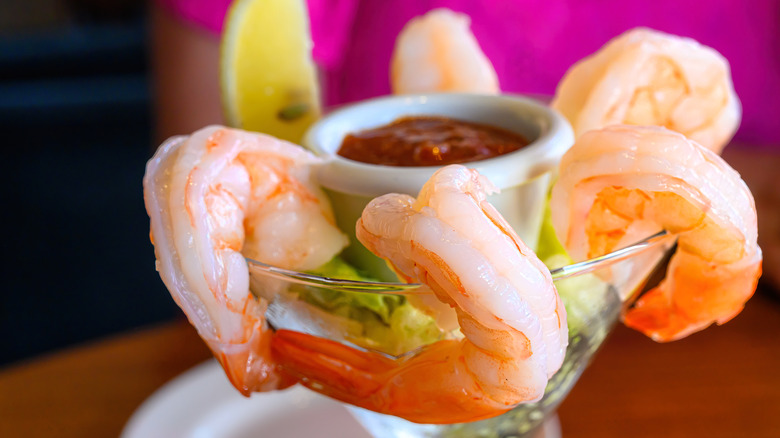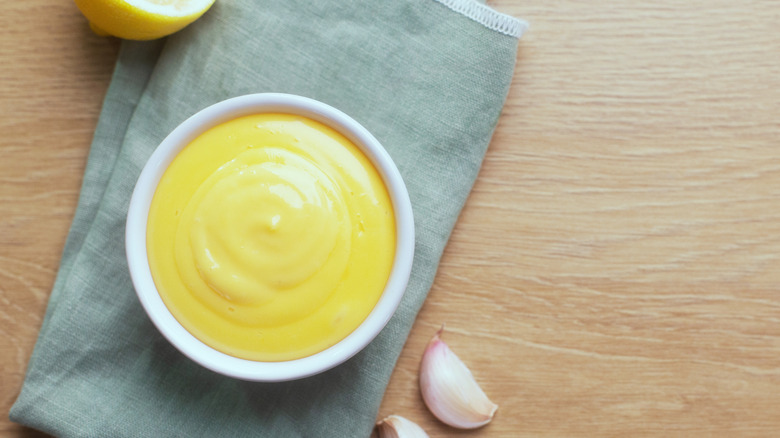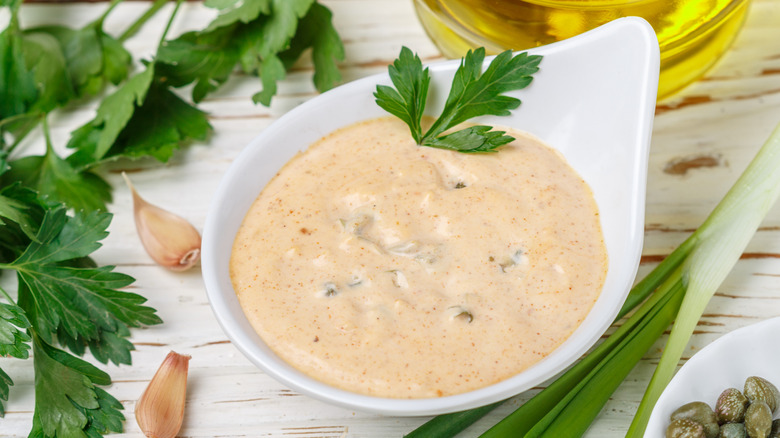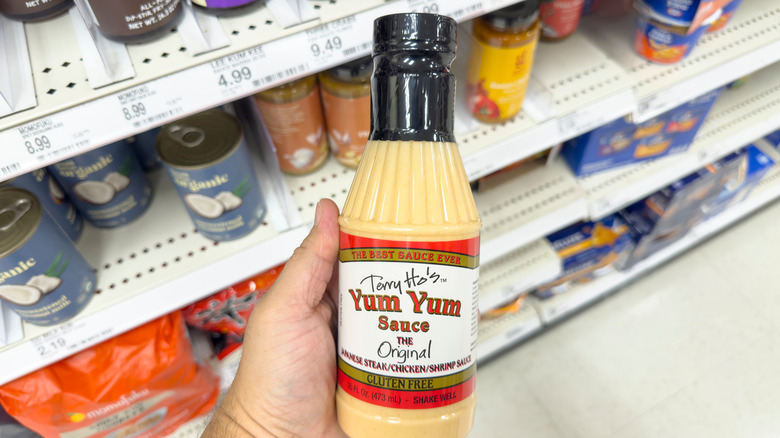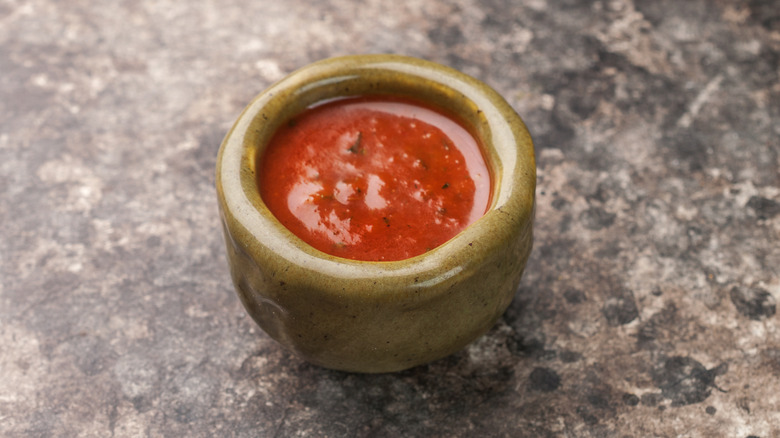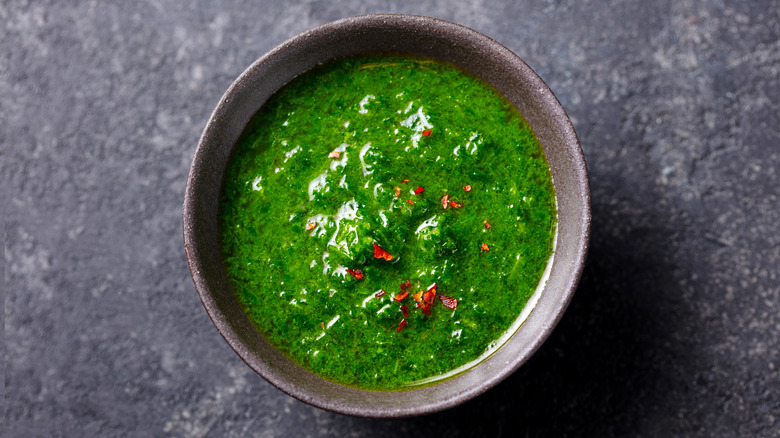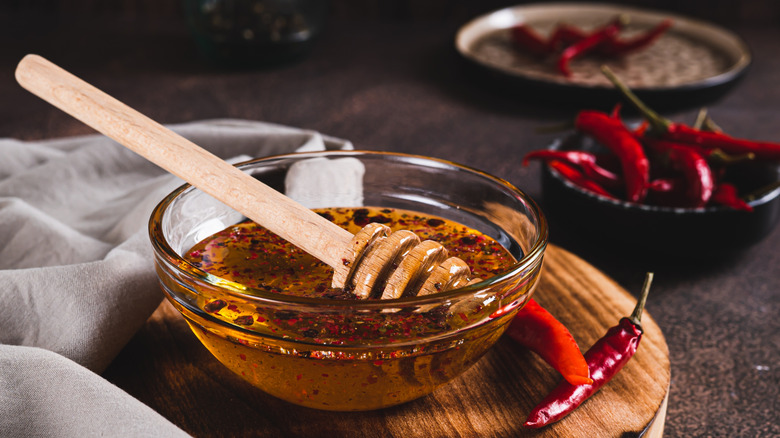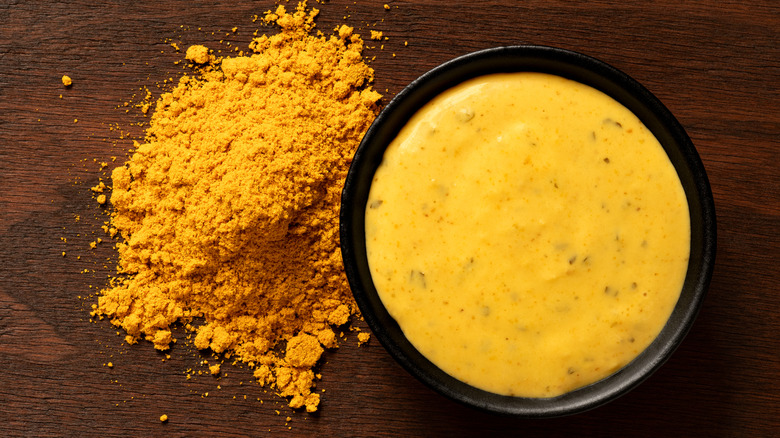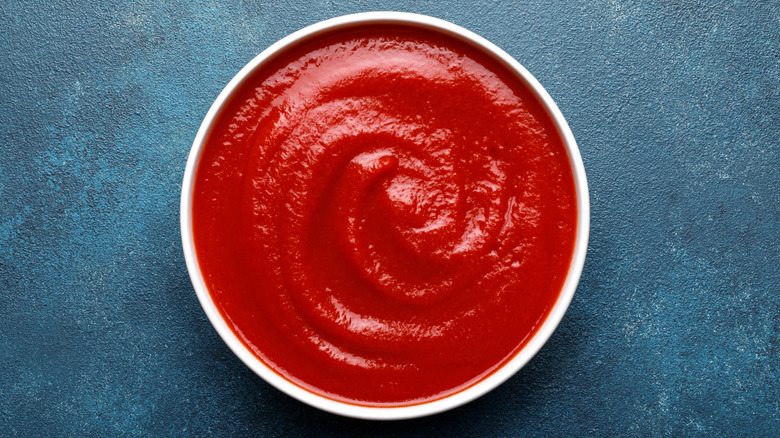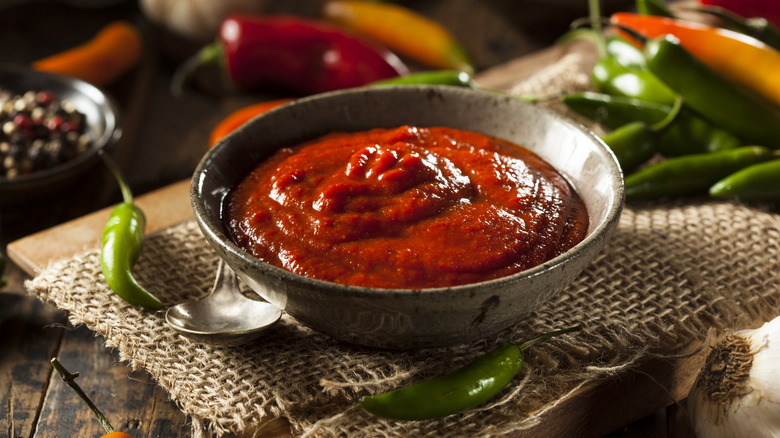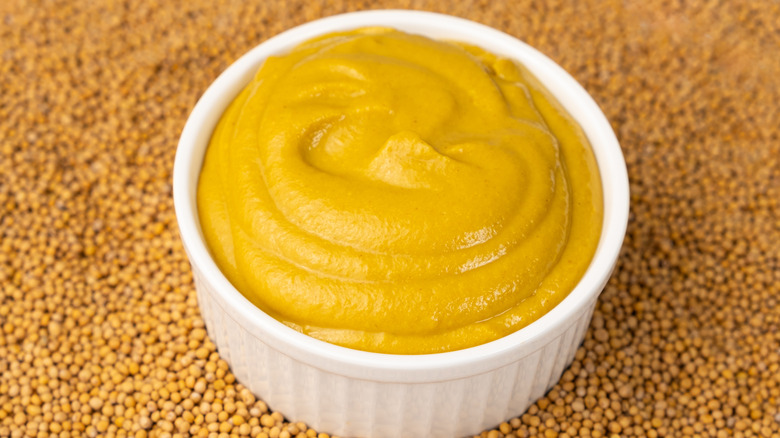12 Dips For Shrimp That Aren't The Traditional Cocktail Sauce
If dipping shrimp is the topic of conversation, cocktail sauce is what is usually top of mind. The gold standard of crustacean condiments has been around since Prohibition, when serving the sauce in a cocktail glass with shrimp dangling from the edge became a popular way to repurpose said cocktail glasses (since they were no longer legally allowed to be filled with hooch). At its heart is an alluring spicy, umami mix of ketchup, horseradish, and lemon that for most folks pairs magically with shrimp.
Yet cocktail sauce also has its detractors who have an aversion to one or more of its main ingredients. Let's face it — much like anything a majority of people enjoy, it's just not for everybody. Additionally, fans of cocktail sauce also deserve a little something different from time to time, and naked shrimp with nothing on it simply lacks the proper amount of flavor to justify serving at your next shindig.
Since it's important to remember that trying different things can lead to a new appreciation of what you may take for granted, let's run down a dipper's dozen alternatives to traditional cocktail sauce with which to pimp your shrimp.
Aioli
Not to begin alphabetically, but this food culture phenomena that could be dismissively described as mayonnaise's more refined cousin is currently enjoying an extended 15 minutes of fame — check out the menu of almost any "New American Cuisine" restaurant menu and you're bound to find it somewhere. And that's the thing: It's not just mayonnaise seasoned with garlic, as mayonnaise consists of emulsified eggs and canola oil. Aioli, meanwhile, has the elevated characteristics of garlic and olive oil.
The diverse aioli family of sauces is like a silky smooth version of scampi, the butter based sauce with which it shares the base ingredients of garlic and lemon. Generally speaking, the creaminess and tanginess of an aioli pairs well with the mild taste and slightly chewy texture of shrimp. And once you consider the plethora of add ons available to mix right in, it can also be a blank canvas with which to take in as many different directions as your palette can handle as you paint a shrimp dip masterpiece.
Remoulade
Originating in France and now considered a key element within Louisiana Creole cuisine, remoulade sauce is by no means simply French aioli. It does share some of the same traits as aioli, namely the velvety feel of emulsified egg, but it takes things down a distinctively different "rue de saveur" (that's just French for "flavor road," y'all). It does this by adding a variety of herbs and spices, as well as everything from hot sauce to anchovies, capers, cornichon, and even curry.
In New Orleans, the style of remoulade made popular by Creole chefs such as Paul Prudhomme consistently features horseradish and Creole mustard (with Dijon mustard serving as an acceptable substitute). In addition to these two staple ingredients, what makes it so region-specific is the addition of Cajun and/or Creole spices. It has a piquant tang specific to the Bayou that no respectable shrimp po' boy would do without.
Yum yum sauce
The name kind of says it all, doesn't it? The popular Japanese steakhouse sauce takes its main ingredient, which happens to be mayonnaise yet again, in a totally different direction with Asian flavors like rice vinegar and sesame oil that add a whole new level of rich complexity. And here's the kicker: Yum yum sauce is not even a traditional Japanese sauce, but one developed through Japanese-American fusion (consider the name itself as kind of a giveaway).
It originally became popular in American hibachi-style steakhouses for its dippable versatility for everything from meats to veggies to, yes, shrimp. Also known as shrimp sauce or Sakura sauce, yum yum sauce achieves that "goes with everything" quality by combining a little bit of everything from the flavor profile rainbow, including an aspect common in Asian cooking which the Koreans refer to as gosoham. It's not just for steakhouses anymore — there are several variations you can buy pre-made, or you can throw a quick dip together in no time.
Sweet chili sauce
Moving on to a sauce option that legitimately has ties to traditional Asian cuisine, sweet chili sauce combines a fruity base with chili peppers and a citrus finish. It achieves a lovely balance of those familiar tastes, it doesn't have a drop of mayonnaise in it (a first on this list, so far), and is a perfect flavor bomb for mild flavored proteins like shrimp. And though it's normally associated with breaded coconut shrimp, the less crunchy cocktail version makes itself at home in this sauce, too.
Sweet chili sauce has its origins in Thai cooking, and should not be confused with sweet and sour sauce (think of the former as sweet and spicy as opposed to the latter). That sauce, like yum yum sauce, has its origins in Asian-American fusion but is by all means a delicious way to have your shrimp prepared at your favorite Chinese restaurant. While the inclusion of chile peppers, particularly Thai spur chiles known as prik chee fa, gives the sauce a touch of heat, it is rather mild in comparison to other dipping options and often quite kid friendly.
Chimichurri
Chimichurri might be the most delicious thing to ever come out of Argentina, with the possible exception of the mouth-watering grilled meats that it typically accompanies. While it is the sauce of choice for the gauchos of the Argentine pampas, its origin is a little murky. Some attribute it to Basque settlers, as the similar-sounding Basque for word tximitxurri means "hodgepodge." Still others say it is a version of an English Jimmy McCurry sauce.
While one may think primarily of steak when considering chimichurri, its herbaceous, zesty kick goes with all just about everything, including shrimp. Its earthy flavor blends beautifully with shrimp's mildness. Like pesto without the Parmesan cheese and pine nuts, and even closer to an Italian salsa verde that incorporates anchovies and capers, chimichurri's bright, acidic flavors pair well with seafood, again because shrimp has such a delicate taste and lively texture. And if you have leftover chimichurri post shrimp imbibing, you can always add it to your eggs for breakfast the next morning.
Hot honey
This popular condiment has exploded over the last several years and can now be found everywhere, probably due to the fact that it's an ideal combination of sweet and heat. Hot honey differs primarily from its Thai sweet chili cousin due to honey's earthy, floral flavor, in contrast to the fruitiness of typical sweet chili components such as mango, pineapple, or passion fruit. This flavor blend paired with its consistency makes it a delicious dip for breaded or cocktail shrimp.
In the U.S., hot honey's boom is thanks in large part to Mike Kurtz, aka the "Mike" in Mike's Hot Honey. Kurtz came across a chile pepper-infused honey served tableside while visiting a Brazilian pizzeria twenty odd years ago, and within a year or so later he had developed his own proprietary version that was responsible for kicking the whole hot honey craze off stateside. If dipping your shrimp in it simply isn't enough for you, you could always just use hot honey to marinate it.
Tartar sauce
Almost everyone is familiar with this old school classic dunker for a variety of seafood, and it shares a lot of the same characteristics that make aioli and remoulade work for shrimp. What you may not know is that it was originally served as an accompaniment to steak tartare, the infamous and basically well-seasoned raw meat dish once "très populaire" in French cuisine.
For modern shrimp dipping purposes, pickles (or pickled relish) are the key to a great tartar sauce. Like many a sauce previously mentioned, there is a heretofore unmentioned mixture of cool, creamy, and crunchy that is playful to taste once mayo meets pickle. When making your own at home, the possibilities for different enhanced flavors like chipotle or garlic, and crunchers like onions, peppers or jalapenos, are endless. Now matter how you game things out, it's a great alternative to sweet chili when dunking cocktail shrimp.
Clarified butter
Nothing compliments shellfish like clarified, or drawn, butter. It introduces an element of richness that boosts the enjoyment of the meat with an umami immersion. The effortlessly enjoyable melding of shrimp and dip (or coating, or even drowning, for some) can appear to have an air of sophistication due to a perception of seafood being on the finer end of dining, but there isn't a sauce on this list that could be more accessible.
Scientifically, the smooth and nutty fat soluble compounds in butter amplify shrimp's natural flavor and create a mouthfeel experience like no other. And when you further add aromatics like garlic and herbs into the mix, the sensations reach a whole other level. There's even a thing called beurre de crustaces, or crustacean butter, where you infuse it with the actual essence of the shellfish. Just don't mix up clarified butter with ghee, a more intense, even nuttier iteration of butter that is also popular throughout the food world.
Curry
Adding to a growing list of Asian contenders by which to derive fanciful shrimp dipping experiences, the term curry refers to both a variety of spice blends and the sauces created from them. Used primarily in Indian and Thai cooking, it's a major element of what makes those cuisines so distinctive. A good curry provides the right balance of salty, sour, and sweet while also being adaptable to various levels of heat.
Red curry always works well with a variety of seafood, including shrimp, and green curry presents a milder flavor for the timid. The longer the shrimp is exposed to the sauce, the better, so you might consider forgoing using curry as a dip and just go straight to cooking a shrimp curry. While that is a delicious endeavor, if you've only got time for a quick dip, shrimp cocktail can go right in, and breaded and fried shrimp will hold and incorporate the sauce as well.
Ketchup
Don't scroll past this one dismissively because, seriously, what doesn't taste good with some ketchup on it (with the exception of possibly dessert)? As a condiment, ketchup is ubiquitous, and as such, simply one of the most versatile flavor additions around. It also veers ever so closely into traditional cocktail sauce's tomatoey waters, as it is a main ingredient in many cocktail sauce versions.
Exactly why ketchup tastes so good on pretty much everything, and specifically shrimp, has to do with that magic mixture of sugar, salt, and vinegar that make up almost all variations in some manner or measurement. They come together and all add up to that "U" word again, umami. Whatever you believe makes the world go round, for dipping shrimp, it's really all about the umami, which ketchup perfectly embodies. And it doesn't do it in an overpowering way; there are no extreme elements in basic ketchup to drive picky eaters away, unless they simply have an irrational fear of it.
Sriracha
Sriracha is so distinctive for its depth of flavor and heat that it simply could not be passed over for this shrimp dipping discussion. The Thai chili sauce's characteristic profiles of sweet, sour, and spicy have been highlighted throughout so many of the sauces listed here, so logic dictates that it's a winner for a shrimp dipping dinner. Yet while all the familiar tasting notes are there, the delicious devil is in the details. Many of the ingredients in sriracha are also common to sweet chili sauce, but in different proportions they make for a singularly versatile dipper.
Most Americans are familiar with the Huy Fong brand, often called "rooster sauce" because of its well known label, but there are many different brands to choose from that tweak the basic formula of chili paste, vinegar, garlic, sugar, and salt. Whichever sriracha you prefer, including your homemade version, you probably haven't tasted the original. Don't let that fact start you tripping — just keep dipping!
Honey mustard
Sometimes, just as the answer to shrimp isn't always cocktail sauce, the answer to sweet isn't always heat. If you're looking to balance contrasting boldness in unexpected epicurean ways, honey mustard hits all the right notes to reach flavor harmony. While some sauces work better with breaded and fried shrimp, honey mustard is an all-around dip that does quite well with shrimp that's been grilled or, of course, boiled for cocktail.
While the origins of honey mustard are somewhat debatable, the tangy trail turns decidedly sweet around the 4th century, when Roman agronomist Palladius created a recipe incorporating white mustard seed with some basic ingredients like olive oil, white wine vinegar, and honey. Today, there's truly nothing boring about using it to dunk shrimp prepared any way you like it, and you could take it a step further, skip the dip, and toss grilled shrimp into a yummy honey mustard vinaigrette salad.
